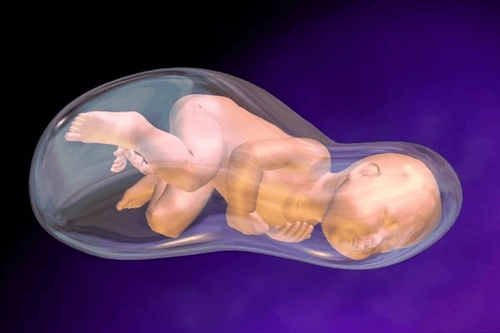This is an automatically translated article.
The article was professionally consulted by Specialist Doctor I Le Hong Lien - Department of Obstetrics and Gynecology - Vinmec Central Park International General Hospital. Doctor Lien has over 10 years of experience as a radiologist in the Department of Ultrasound at the leading hospital in the field of obstetrics and gynecology in the South - Tu Du Hospital.Amniotic fluid plays an important role in fetal development. Depending on the specific stage of pregnancy, the amount of amniotic fluid can increase or decrease differently. If there is too much amniotic fluid in the womb, polyhydramnios will cause dangerous complications.
1. What is polyhydramnios?
About 20 days after conception, amniotic fluid will begin to form. Amniotic fluid contains nutrients, which support the development of the baby's limbs, lungs, and digestive organs. In addition, amniotic fluid also helps to cover and keep the fetus always maintaining a stable body temperature, avoiding injuries while in the womb.By the 37th week of pregnancy, the amount of amniotic fluid can increase to about 1 liter. By week 40, the amount of amniotic fluid will drop to about 0.5 liters. The baby will often swallow amniotic fluid and then excrete it in the form of urine. This helps control the amount of amniotic fluid in the body. If the volume of amniotic fluid increases rapidly, it will make pregnant women feel uncomfortable and heavy. This is called polyhydramnios.
Polyhydramnios usually occurs when the amount of amniotic fluid increases to 2 liters or more. Even in many cases, the amount of amniotic fluid can increase 3 times compared to normal.
Polyhydramnios only occurs in about 1% of pregnancy. To determine if you have polyhydramnios, pregnant women need to have an ultrasound. If the amniotic fluid index through ultrasound exceeds 25 cm, it means you have polyhydramnios.
2. How to diagnose polyhydramnios?
Polyhydramnios is divided into two types, acute polyhydramnios and chronic polyhydramnios with specific symptoms such as:2.1. Acute polyhydramnios
Acute polyhydramnios usually occurs between 16 and 20 weeks of pregnancy and lasts for a few hours. Acute polyhydramnios causes severe symptoms or induces labor before 28 weeks. Amniotic fluid increases rapidly causing the uterus to enlarge, pressing on the diaphragm. Depending on the degree of polyhydramnios, pregnant women may show symptoms such as:Tight abdomen, rapid enlargement. The uterus is tight and painful. Fetal organs are not palpable or there are signs of floating stones. Hard to hear fetal heart. The cervix is open, the amniotic sac is dilated, the lower part of the vagina is distended. Varicose veins, edema of the lower extremities due to compression of the vena cava. Shortness of breath, respiratory failure.

2.2. Chronic polyhydramnios
Chronic polyhydramnios accounts for up to 95% of cases of polyhydramnios and usually occurs in late pregnancy. Because the symptoms are not too severe and dangerous, the pregnant woman does not have as much pain as when having acute polyhydramnios.Usually, in the last 3 months of pregnancy, you will experience abdominal distension, heaviness, shortness of breath, rapid heartbeat. Conducting an examination will see symptoms such as:
The uterus is larger than the gestational age. There are signs of crashing waves. There are signs of floating stones, difficult to determine the fetal poles. The lower part of the vagina is distended.
3. Dangerous complications of polyhydramnios
If polyhydramnios occurs early and the amount of amniotic fluid increases rapidly, the risk of complications is very high. Here are some dangerous complications that can occur when pregnant women have polyhydramnios:Premature rupture of membranes due to too much amniotic fluid in the uterus. Babies born breech, difficult to give birth. Placenta abruption. Umbilical cord prolapse. Affects skeletal development and fetal growth. Ease of risk during vaginal birth, easy postpartum infection. The baby was born prematurely, so the parts are not fully developed. The risk of postpartum bleeding is higher because the uterus is compressed by the large amount of amniotic fluid and cannot fully contract as normal. Stillbirth.
4. A lot of amniotic fluid during pregnancy, what to do?
Most cases of mild to moderate polyhydramnios will not be too dangerous. However, many women still do not know what to do with a lot of amniotic fluid?In case of severe polyhydramnios, there are dangerous symptoms such as: difficulty breathing, chest tightness, rapid abdomen... you need to be hospitalized for continuous monitoring. If the amount of fluid increases too quickly, the woman needs amniocentesis to reduce the amniotic fluid. However, this procedure can lead to complications such as amniotic fluid rupture, amniotic fluid infection, placental abruption...
In case of severe polyhydramnios, dangerous symptoms appear such as: difficulty breathing, chest tightness, your belly grows fast...you need to be hospitalized for continuous monitoring. If the amount of fluid increases too quickly, the woman needs amniocentesis to reduce the amniotic fluid. However, this procedure can lead to complications such as amniotic fluid rupture, amniotic infection, placental abruption...

Polyhydramnios in the last 3 months If you have polyhydramnios in the last 3 months, your doctor will check the fetal growth chart. Depending on the test results, the doctor will conduct tests for the fetus. In some cases, pregnant women will be prescribed lung maturation drugs to avoid the risk of premature birth. If the symptoms of acute polyhydramnios are life-threatening, the doctor will conduct aspiration to remove the amniotic fluid. In addition, to avoid excess amniotic fluid, pregnant women need to build a reasonable diet and pay attention to rest during pregnancy.
At the Department of Obstetrics and Gynecology - Vinmec International General Hospital, has handled many difficult cases such as: polyhydramnios, placenta accreta, knotted umbilical cord, premature pregnancy..., helping pregnant mothers to have a successful labor. In order for the pregnancy process to be comprehensively monitored, Vinmec implements a PACKAGE Maternity program, which includes a full range of prenatal care, during childbirth and after birth. Pregnant women are monitored and carried out all necessary tests and ultrasounds to detect pregnancy abnormalities early.
With a team of highly qualified doctors, a system of ultrasound machines, modernly equipped medical equipment and an accurate and scientific pregnancy examination process, Vinmec will promptly recognize abnormalities in time. pregnancy and appropriate treatment. Carefully preparing both mother and baby supplies, giving birth at Vinmec will be as "gentle" as going on vacation.
Please dial HOTLINE for more information or register for an appointment HERE. Download MyVinmec app to make appointments faster and to manage your bookings easily.
Please dial HOTLINE for more information or register for an appointment HERE. Download MyVinmec app to make appointments faster and to manage your bookings easily.














